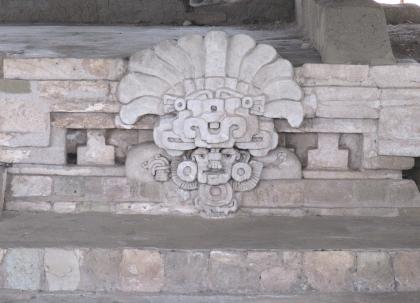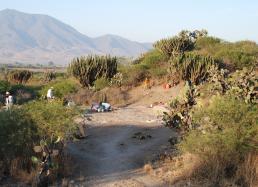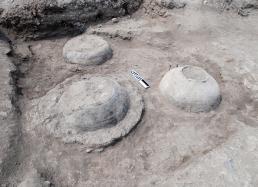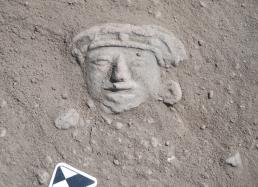5: From Salt Making to Temple Service
Archaeology is often characterized as being esoteric, effete, and of little relevance. During the discipline’s long history, sometimes those critiques have had validity. But when practiced well, archaeology can yield information of much greater and broader relevance. It's one of the few disciplines that can document human behavior across the broad sweep of history and at a global scale.
Of course, documentary history covers some of the same scope, often at a level of detail and precision unachievable through the archaeological spade. But certainly prior to the last few hundred years, documents have basically yielded the perspectives of (and perspectives on) the winners, the powerful, the learned, and the wealthy. What about the stories of the rest of the population, and most of the world, where writing either did not exist, did not preserve, or remains largely undeciphered?
The Zapotecs of the Valley of Oaxaca had one of prehispanic Mexico’s earliest civilizations. They also devised one of the area’s earliest writing systems, a corpus of glyphs that preceded the famous and now much-better-understood writing of the Maya. Unfortunately, beyond the calendar and numbers, much of the meaning of Zapotec writing remains outside the realm of scholarly knowledge. Thus most of what we know about the Valley of Oaxaca must come from archaeology.
For the contemporary Zapotec people, whose ancestors lived in the region before the Spanish arrived, archaeology is practically the only way to extend the history of their lives and culture back more than a half-millennium. But beyond direct descendants, what can the history of the Zapotecs tell us?
As mentioned previously, one of the key questions that has long intrigued me is what led to the declining size and diminishing power of the early city of Monte Albán between A.D. 500-900. From the foundation of Zapotec civilization (ca. 500 B.C.) until almost the end of the first millennium A.D., Monte Albán was a unique place in the region. Situated on a hilltop at the apex of the region’s three subvalleys, its setting was unlike any other. In addition, its size well exceeded other towns, while its architectural majesty and grand Main Plaza were for centuries unrivaled. And for hundreds of years, Monte Albán had a near-monopoly on the creation and display of written Zapotec texts.
How can we understand what brought Monte Albán’s more than a millennium of regional dominance to its end? Throughout global history, there aren’t that many places that maintained this kind of predominance over their neighbors for such an extended period, so trying to make sense of the causes and consequences of this transition of regional power has broader ramifications for the analyses of societal change.
As mentioned in an earlier dispatch, Lambityeco has been an integral site for understanding the process of political change and the breakdown that occurred in the Valley of Oaxaca during the second half of the first millennium A.D. The elaboration of Lambityeco’s role in this series of events owes most to the studies led by John Paddock and the publications that draw on his research, which ultimately were published by his loyal colleagues and students, Michael Lind and Javier Urcid.
Paddock’s investigations focused primarily on two mound complexes (Mound 195 and Mound 190) that now constitute INAH’s current archaeological zone and sit not far from Mound 165, where we are studying. Mound 195 is thought to have been the palace of a lordly family that had a leadership role at Lambityeco for generations.
Mound 190 is harder to interpret. It, too, was laid out in the form of a palace, but it included a room that was dominated by two plaster sculptures of Cocijo, a prevalent Zapotec supernatural force associated with lightning. As one hypothesis, Lind and Urcid propose that this small room may have been a place where the privileged young of Lambityeco came to be instructed about this key supernatural being by the residents of this elaborate structure.
Cocijo, with his bifurcated reptilian tongue, was the most commonly represented supernatural at Monte Albán over the course of its history and was represented on Zapotec effigy vessels or urns that were made and used across the region during the Classic period (ca. A.D. 200-850/900).
What’s curious about Mound 190 is that the elaborately carved stucco sculptures of Cocijo (see above photo) pertain to the earliest occupational episode of this structure and that after this use, these impressive plaster representations were covered over and were not visible or exposed during three subsequent building episodes. I wonder whether the role of Cocijo shifted at Lambityeco, as the leaders at the latter site stretched to establish degrees of autonomy from Monte Albán?
Mound 165, our focus, clearly was a less elaborate residence than either Mounds 190 or 195, but it also has the form of a higher-status (as opposed to a commoner) residence. In addition, Mound 165’s position adjacent to the tallest mound at the site (Mound 155—see Photo #1 below) reflects a degree of centrality and, perhaps, clues to its history and function.
In the previous dispatch, I mentioned that although the production of pottery and salt were key economic activities for the people who lived at Lambityeco during the Classic period, we had no clear indications for either. That statement now requires correction. In fact, just in the last few days, we did find direct evidence for the processing of salt in large jars on Mound 165.
What makes this finding doubly interesting is that this activity apparently only was enacted early in the history of Mound 165. After constructing their house so that four giant jars (in which salt was extracted from briny lagoon water) were literally planted into the northwest corner of the structure (see Photos #2 and #3 below), these jars, like the Cocijos of Mound 190, subsequently were covered and we have no later indications of salt making on Mound 165. Of course, the manufacture of salt continued elsewhere at Lambityeco, but just not at Mound 165. So what activities were associated with later occupations of this complex?
In last week’s dispatch, I eluded to the incredible numbers of figurines that we were uncovering during our excavations. We have many, many bags of pottery still to study and tabulate, and our current figurine count exceeds 400. To put that in context, when we unearthed the most elaborate palace at El Palmillo, we recovered fewer than 200 figurines during two field seasons, even though it was a larger and architecturally more elaborate residence than Mound 165, Lambityeco.
How figurines were used in prehispanic Mesoamerica has been a matter of considerable debate. Generally, they're associated with private or domestic rituals (as opposed to more public behaviors), since most figurines have been archaeologically recovered in domestic contexts. And yet, given the proximity of Mound 165 to Mound 155 (hypothesized to have been Lambityeco’s tallest temple), there may be tie-ins between domestic and public ritual practice.
In the middle occupational levels of Mound 165, we also observed abundances in classes of artifacts indicative of food preparation (such as large numbers of used tortilla griddle fragments) as well as large serving vessels, and even a surprising number of carbonized maize cobs (see Photo #4 below). These findings could reflect rites associated with the nearby temple. For example, the later Aztec in central Mexico engaged in ritual food dispersals in which maize was prepared into breads in the shape of people and supernatural figures that were handed out during specific rites held near (and when entering) temples.
While in the field, it has been our impression that the quantity of figurines in Mound 165 diminished somewhat as we excavated down through the occupational levels. To put it another way, we think the abundance of figurines was noticeably lower during the early time when salt making was occurring in this structure, but then increased markedly thereafter, when salt manufacturing ceased to be practiced.
The figurines may provide clues as to how residents of Mound 165 focused their activities after they dropped salt production. When the salt-making ollas were abandoned, three figurines were placed face-up around them (see Photo #5 below.) Does this change in activities reflect merely an occupational shift or something more? Could any of these changes be linked to the burying of the Cocijo sculptures at Mound 190, or possibly to the growing estrangement between Monte Albán and Lambityeco during this period?
We’re still very early in our study, but with luck and concerted work, just maybe we'll be able to advance a few preliminary links and hypotheses in the weeks to come that may help us to understand some of the social processes that contributed to the unraveling of Monte Albán’s hegemony.
More soon,
Gary









